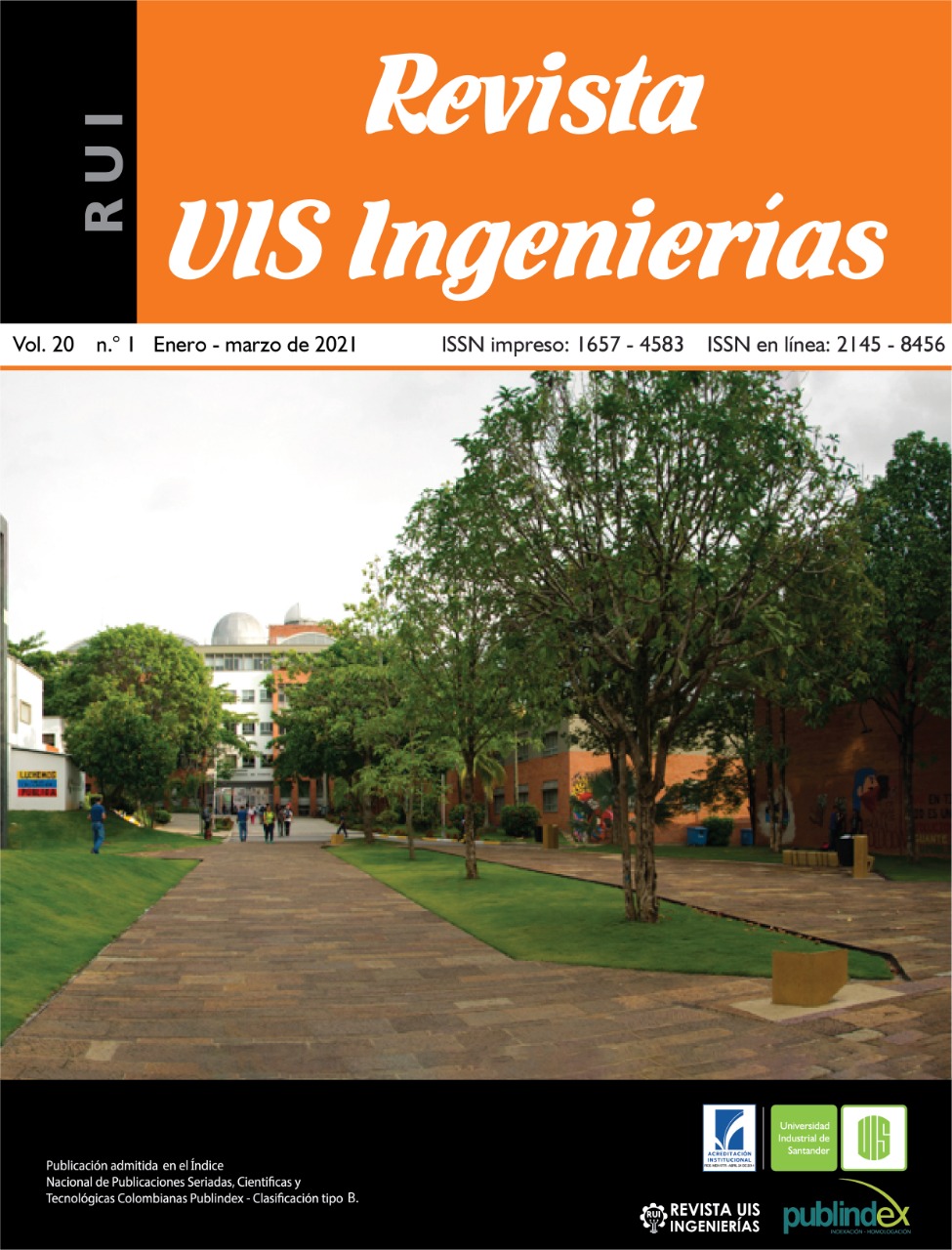Influence of the earthing systems described in the IEEE 1243 Standard on the back-flashover rate of transmission lines
Published 2020-11-19
Keywords
- atmospheric discharges,
- ATPDraw,
- back-flashover rate,
- failure rate,
- grounding system
- IEEE 1243,
- transmission lines ...More
How to Cite
Copyright (c) 2020 Revista UIS Ingenierías

This work is licensed under a Creative Commons Attribution-NoDerivatives 4.0 International License.
Abstract
This work deals with two kind of resistive models for grounding in transmission lines portrayed in the IEEE 1243-1997 Standard: counterpoises and supplemental groundings rods. It is analyzed the effect of varying the internal parameters of each model that affect the resistive value of grounding in the reduction or the increase of the back-flashover rate due to lightning strikes to the structure or to the ground wire over terrains with several conductivities. It is used the ATPDraw software to obtain the critical currents and then to obtain the back-flashover rate of the line. It was simulated the effect of the number, longitude, radius and depth of the electrodes in the back-flashover rate of a transmission line for several values of ground conductivity. It was obtained reductions percentages of the back-flashover rate between 50 and 95%.
Downloads
References
[2] H. Torres, “El espacio y el tiempo en los parámetros del rayo”, en El rayo. Mitos, leyendas, ciencia y tecnología, 2ª ed., Bogotá, Colombia: UNIBIBLOS, 2002, pp. 123-131.
[3] CIGRE Working Group of Lightning, Guide to the procedures for estimating the lightning performance of transmission lines. CIGRE, Paris, Francia, 1991.
[4] A.R. Hileman, Insulation coordination for power systems. Boca Raton, FL, USA: CRC Press, 1999.
[5] F. Casas, Tierras: soporte de la Seguridad Eléctrica, 3ª ed. Bogotá, Colombia: ICONTEC, 2006.
[6] F.M. Gatta, A. Geri, S. Lauria, M. Maccioni, “Backflashover simulation of HV transmission lines with enhanced counterpoise groundings”, Electric Power System Research, vol. 79, no. 7, pp. 1076-1084, 2009, doi: 10.1016/j.epsr.2009.01.008
[7] W. A. Chisholm, W. Janischewskyj, “Lightning surge response of ground electrodes”, IEEE Transactions on Power Delivery, vol. 9, no. 4, pp. 95-95, 1989, doi: 10.1109/MPER.1989.4310635
[8] “Guide for Improving the Lightning Performance of Transmission Lines”, en IEEE Std 1243-1997, pp.1-44, 16 dec. 1997, doi: 10.1109/IEEESTD.1997.84660
[9] IEEE working group report, “Estimating lightning performance of transmission lines II – Updates to analytical models”, IEEE Transactions on Power Delivery, vol.8, no.3, pp. 1254-1267, 1993.
[10] J. A. Martinez, F. Castro-Aranda, “Lightning performance of transmission lines using the EMTP”, en IEEE Power engineering society general meeting (IEEE Cat. No 03CH37491), Toronto, Ontario, Canadá, 2003, pp. 295-300, doi: 10.1109 / PES.2003.1267186
[11] I. M. Dudurych, T. J. Gallagher, J. Corbett, M. V. Escudero, “EMTP analysis of the lightning performance of a HV transmission line”, en IEE Proceedings - Generation, Transmission and Distribution, vol. 150, no. 4, pp. 501-506, 2003, doi: 10.1049/ip-gtd:20030252
[12] M. Z. A. Ab. Kadir, I. Cotton, “Implementation of the modified leader progression model in backflashover analysis”, en IEEE International Power and Energy Conference, Putra Jaya, Malasia, 2006, pp. 516-521, doi: 10.1109 / PECON.2006.346706
[13] H. Swalehe, P. V. Chombo, B. Marungsri, “Flashover and back-flashover analysis with lightning strokes of 69 kV and 24 kV lines in Thailand using ATP/EMTP”, International Journal of Energy Conversion., vol. 6, no. 4, pp. 111-120, 2018.
[14] M. A. Abd-Allah, T. Elyan, “Analysis for Egyptian 500kV and 220kV Transmission towers”, International Journal of Scientific and Research Publications, vol. 6, no. 4, pp. 289-297, 2016.
[15] I. L. Avila, G.F. di Mauro, J. A. Suárez, “Estudio de los efectos de las descargas atmosféricas sobre la confiabilidad de las líneas aéreas de transporte de energía”, en III Congreso De las Américas de Distribución Eléctrica, Ciudad de Córdoba, Argentina, 2016.
[16] A. Halim, A. Bakar, H. Mokhlis, S. A. Halim, S. Sarah, M. Isa, H. A. Illias, “Analysis of Arrester Energy for 132kV Overhead Transmission Line due to Back Flashover and Shielding Failure”, en IEEE International Conference on Power and Energy (PECon), Kota Kinabalu, 2012, pp. 683-688, doi: 10.1109/PECon.2012.6450302
[17] B. Marungsri, S. Boonpoke, A. Rawangpai, A. Oonsivilai, C. Kritayakornupong, “Study of Tower Grounding Resistance Effected Back Flashover to 500 kV Transmission Line in Thailand by using ATP/EMTP”, International Journal of Electrical and Electronics Engineering, vol. 3, no. 10, pp. 617-624, 2009.
[18] F.M. Gatta, A. Geri, S. Lauria, “Backflashover simulation of HV transmission lines with concentrated tower grounding”, Electric Power System Research, vol. 73, no. 3, pp. 373-381, 2005, doi: 10.1016/j.epsr.2004.08.011
[19] F. M. Gatta, A. Geri, S. Lauria, M. Maccioni, “Backflashover simulation of HV transmission lines with enhanced counterpoise groundings”, Electric Power System Research, vol. 79, no. 7, pp. 1076-1084, 2009, doi: 10.1016/j.epsr.2009.01.008
[20] S. Visacro, F. H. Silveira, “Lightning Performance of Transmission Lines: Requirements of Tower-Footing Electrodes Consisting of Long Counterpoise Wires”, IEEE Transactions on Power Delivery, vol. 31, no. 4, pp. 1524-1532, 2016, doi: 10.1109/TPWRD.2015.2494520
[21] J. Montaña, “Recommendations for grounding systems in lightning protection systems”, Ingeniería e Investigación, vol. 31, no. 2, pp. 5-10, 2011.
[22] R. Shariatinasab, J. Gholinezhad, “The effect of grounding system modeling on lightning-related studies of transmission lines”, Journal of Applied Research Technolology, vol. 15, no. 6, pp. 545-554, 2017.
[23] M.A. Sargent, M. Darveniza, “Tower surge impedance”, IEEE Transactions On Power Apparatus and Systems, vol. 88, no. 5, pp. 680-687, 1969, doi: 10.1109 / TPAS.1969.292357
[24] H. W. Dommel, “Electromagnetic Transients Program Reference Manual. EMTP Theory Book”, en Prepared for Bonneville Power Administration, Portland, OR, USA, 1986.
[25] Ministerio de Minas y Energía, Reglamento Técnico de Instalaciones Eléctricas, 2013.
[26] M. Darveniza, F. Popolansky, E. R. Whitehead, “Lightning protection of UHV transmission lines”, Electra, no. 41, pp. 39-69, 1975.
